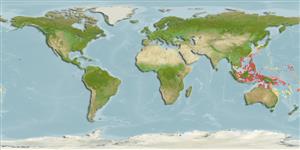>
Gobiiformes (Gobies) >
Gobiidae (Gobies) > Gobiinae
Etymology: Cristatogobius: Latin, cristatus = crested + latin, gobius = gudgeon (Ref. 45335).
More on author: Herre.
Environment: milieu / climate zone / depth range / distribution range
Ecología
marino; salobre demersal; rango de profundidad 0 - 12 m (Ref. 37940). Subtropical
Distribución
Países | Áreas FAO | Ecosistemas | Ocurrencias, apariciones | Point map | Introducciones | Faunafri
Western Pacific: Japan, Philippines, Thailand and Indonesia.
Tamaño / Peso / Age
Maturity: Lm ? range ? - ? cm
Max length : 5.1 cm SL macho / no sexado; (Ref. 37940)
Espinas dorsales (total): 7; Radios blandos dorsales (total): 9-10; Espinas anales 1; Radios blandos anales: 8 - 9; Vértebra: 26. Black spots on head, body, and pectoral fin base. Larger round to elongate iridescent pale blue or green spots scattered on head and upper anterior part of body, those on upper anterior part of body surrounded both above and below with elongate and inwardly curved or roundish dark brown spots. Several brown transverse bands from dorsal to ventral sides of body. Second dorsal fin mottled with red, yellow, and grey with black spots usually present. Anal fin separated into proximal red and distal black areas with a yellow line on red area close to black area. Caudal fin somewhat lanceolate (Ref. 37940).
Found in brackish waters (Ref. 43239). Occurs in river mouths and bays, on muddy bottoms (Ref. 37940). Found in burrows dug by Alpheus shrimp and other invertebrates (Ref. 37940).
Life cycle and mating behavior
Madurez | Reproducción | Puesta | Huevos | Fecundidad | Larva
Akihito and K. Meguro, 2000. Review of the gobiid genus Cristatogobius found in Japan with description of a new species. Ichthyol. Res. 47(3):249-261. (Ref. 37940)
IUCN Red List Status (Ref. 130435)
Threat to humans
Harmless
Human uses
Más información
PaísesÁreas FAOEcosistemasOcurrencias, aparicionesIntroduccionesStocksEcologíaDietacomponentes alimenticiosconsumo de alimentoRación
Nombres comunesSinónimosMetabolismoDespredadoresEcotoxicologíaReproducciónMadurezPuestaAgregación para la puestaFecundidadHuevosEgg development
Age/SizeCrecimientoLength-weightLength-lengthLength-frequenciesMorfometríaMorfologíaLarvaDinámica larvariaReclutamientoAbundanciaBRUVS
ReferenciasAcuiculturaPerfil de acuiculturaRazasGenéticaElectrophoresesheritabilidadEnfermedadesProcesamientoNutrientsMass conversion
ColaboradoresImágenesStamps, Coins Misc.SonidosCiguateraVelocidadTipo de nataciónSuperficie branquialOtolitosCerebrosVisión
Herramientas
Special reports
Download XML
Fuentes de Internet
Estimates based on models
Preferred temperature (Ref.
123201): 26.1 - 29.3, mean 28.8 °C (based on 1344 cells).
Phylogenetic diversity index (Ref.
82804): PD
50 = 0.5312 [Uniqueness, from 0.5 = low to 2.0 = high].
Bayesian length-weight: a=0.00708 (0.00333 - 0.01504), b=3.09 (2.92 - 3.26), in cm total length, based on LWR estimates for this (Sub)family-body shape (Ref.
93245).
Nivel trófico (Ref.
69278): 3.2 ±0.3 se; based on size and trophs of closest relatives
Resiliencia (Ref.
120179): Alto, población duplicada en un tiempo mínimo inferior a 15 meses (Preliminary K or Fecundity.).
Fishing Vulnerability (Ref.
59153): Low vulnerability (10 of 100).
